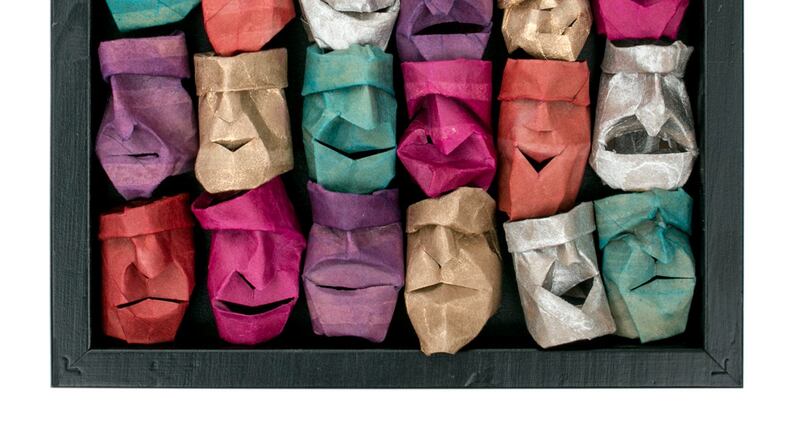>> HISTORY: Forest conceals long-forgotten amusement park, a 1930s Dayton hot spot
“It has been a good distraction from all of the noise on the news,” says the Clayton man, whose day job involves creating and designing lines of pet products. And the repetition has been therapeutic and kept my hands and mind occupied.”
He became fascinated with origami and paper engineering years ago while working with a design firm in England that produced pop-up, three-dimensional greeting cards. It was the lock-down that inspired Daugherty’s current project. “About the time we were watching the news about the shortages of toilet paper, my wife shared a Facebook posting of a French artist, Junior Fritz Jacques, who had been creating sculptural heads and faces using toilet paper tubes,” he explains.
“It really caught my attention and I thought I would spend my time on the couch figuring out how to do this sort of thing,” he says.
>> RELATED: Home studios: 11 local artists tell us what they’ve been working on
It quickly became an obsession.
“How does one fold and twist a toilet paper tube to convert into an expressive face?” he asked himself. “How do I make this my own and what do I do with them when I’m done?”
Working titles helped him formulate a direction. He came up with the title “No one is Perfect —but collectively beautiful.”
“As the world began to broadcast and hold meetings from their homes with their hair out of place, no make-up and the dog barking in the background, it began to humanize everyone and show that the polished side that we see of people is not always reality,” Daugherty says. “This allowed me to loosen up and focus on multiple individual expressions and placing them in mass to create a larger collective expression.”
>> TRENDING: The Pine Club scores another shout-out, this one from the NY Times
The addition of color through staining added another level and helped express more variation and diversity. Melded together these faces express that “no one is perfect – but collectively beautiful.”
Daugherty is about halfway to his goal of 200 individual faces and says he’s not hoarding toilet paper but found that paper towel rolls are the same diameter, and can produce multiple faces. “The large piece will use an estimated 200 faces in 8 - 12-by-12 inch panels,” he says. ” At a pace of about 10 to 15 pieces a day, I am hopeful to have this done by the end of May. “He’s also creating a short video about the process that will incorporate the “twisted” faces of his Facebook friends, reflecting the fact that “we’re all rough around the edges.”
Daugherty and his wife Lori, who has a studio and gallery space at the Front Street Buildings, will be offering several of the smaller 5-by-7-inch pieces. For more information, visit www.dartyart.com.
How art heals
Creative energy keeps us moving, says Leah Stahl, director of the photography and media arts department at Stivers School for the Arts.
“Making art isn’t always fun, and the healing that takes place is rarely wrapped in a cliché bow of rainbows and smiles, but accessing our creativity is essential to learning, understanding and discovering,” she said.
Virtual learning isn’t ideal and has presented obvious challenges, but Stahl says her students haven’t stopped creating and learning. “Accessing creative energy during the quarantine didn’t come naturally for all of our students,” she says. “A lovely mix of anxiety, shock, confusion, grief, and general feelings of unease has crept into us all us at various stages in the past few months. Though these are all normal reactions to a pandemic, shutting down doesn’t leave much space for cultivating ideas and nurturing the parts of us that need connection.”
>> HISTORY: The Dayton Racquet Club once was for 'select' members only — and that meant men
In the Visual Arts department, students have been forced to work with only what they have in their homes. Stahl says that’s turned out to be a wonderful exercise — a way to work with the bare minimum. “We teach our kids how to see. This temporary setback of being out of our classrooms and studios has enabled us to focus on our reasons for creating and really investigate the concepts of serious art-making. Shooting with their cell phones has allowed them to focus on raw ideas and compositional elements without the fear of too much time or materials being spent on it.”
A daily exercise for photography students was to continue shooting “day in the life” shots and noticing how these images are changing over time. “We studied the work of masters and re-created their pieces,” Stahl says. “We made light-sensitive pigments out of kitchen spices and of plants in our neighborhood. We have stayed connected by posting our work in online forums and will continue working collaboratively with mail art projects over the summer. One of the main points I have tried to get through to my kids is that this time we are living is history. How are you spending your days? These dark and confusing times will pass, but the art you have created, the words you’ve written, the music you’ve made will last forever.”
Students react
“During quarantine, I’ve learned to appreciate every tiny thing around me and everything that I have taken for granted as well,” says JulieAnne Moreland, a 10th-grade student at Stivers. Her classmate Penelope Fisher says most of her current work is a reflection of her current mental state. “I feel that the world is moving terribly slowly at the moment and minimal things are happening — at least to me — so I have been exploring more minimalist art forms. I feel that with the stress of the world, minimalism is all that many people’s brains can handle.”
“Quarantine may have me stuck in this house, but that doesn’t mean I can’t create beautiful work says 11th-grader Kyra Stahl. “In some ways, it has even helped me be more creative and find inventive ways to create images.”
Eighth-grade student Lillian Wolford is expressing her feelings about the quarantine through photos and poetry. One of her poems begins:
"Looking out at nothing.
Curled in myself in faux defeat.
Avoiding looking at the simplicity,
Of my little lies and nagging deceit.
An empty, deep and hungry blue,
Of my aloneness, surrounded by faces,
Voices who talk to me and at me,
Never with me, at their own paces.”
Tenth-grader Mea Richards believes this period of time has impacted a lot of people’s mental health and admits it’s hard to find the motivation to create when there’s so much negativity going on. Her photos, she says, reflect on the mental impact of quarantine: “Feelings of being trapped and anxious, but also of hope. Waiting in anticipation for safer times.”
A social worker weighs in
Social worker Pat Acker has always believed that art helps us heal. She’s been affiliated with a number of Hospice organizations over the years and is known for the portraits she has created and given to families of Hospice patients. She also has authored and illustrated a book of Hospice stories entitled “The Dying Teach Us How to Live.”
At the moment, she’s creating a slide show designed to help others overcome their fears and discover their peace and courage titled “Finding Hope in Art.”
One of the images is of her cousin, who died recently from the virus in Michigan and is pictured with her husband. Another is based on a famous painting of Jesus knocking at the door. “I’d been feeling that I was getting into darkness because I was home alone and lonely, not having interactions with other people,” Acker says. “So my painting shows Jesus and a woman opening that door. To me, it’s about opening the door to faith and putting our trust in God.”
Acker said creating art helps us feel part of the world and recommends those of us at home give it a try. “Put an object — like a basket of flowers — in front of you and take a crayon or pen and try to draw it in one continuous line without looking at the paper. Do it to your favorite music. The process helps you to feel, to take a moment in time and forget about the virus and get lost in what you are doing.
“Realize that the final product doesn’t matter. It’s the process of doing it that helps you release your feelings,” she said.
About the Author







